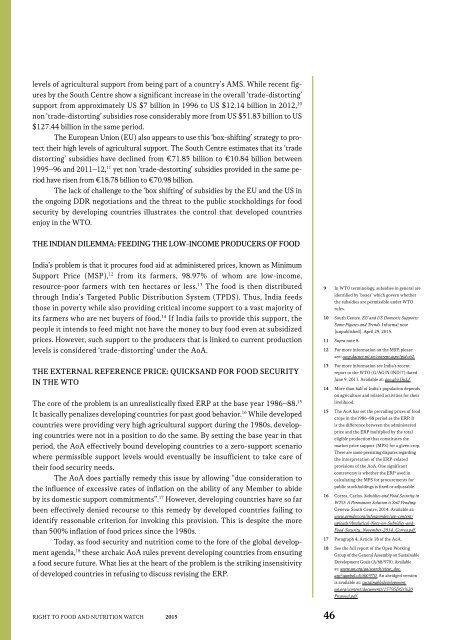RIGHT TO FOOD AND NUTRITION WATCH
1iNBHTY
1iNBHTY
Create successful ePaper yourself
Turn your PDF publications into a flip-book with our unique Google optimized e-Paper software.
levels of agricultural support from being part of a country’s AMS. While recent figures<br />
by the South Centre show a significant increase in the overall ‘trade-distorting’<br />
support from approximately US $7 billion in 1996 to US $12.14 billion in 2012, 10<br />
non ‘trade-distorting’ subsidies rose considerably more from US $51.83 billion to US<br />
$127.44 billion in the same period.<br />
The European Union (EU) also appears to use this ‘box-shifting’ strategy to protect<br />
their high levels of agricultural support. The South Centre estimates that its ‘trade<br />
distorting’ subsidies have declined from €71.85 billion to €10.84 billion between<br />
1995–96 and 2011–12, 11 yet non ‘trade-destorting’ subsidies provided in the same period<br />
have risen from €18.78 billion to €70.98 billion.<br />
The lack of challenge to the ‘box shifting’ of subsidies by the EU and the US in<br />
the ongoing DDR negotiations and the threat to the public stockholdings for food<br />
security by developing countries illustrates the control that developed countries<br />
enjoy in the W<strong>TO</strong>.<br />
THE INDIAN DILEMMA: FEEDING THE LOW-INCOME PRODUCERS OF <strong>FOOD</strong><br />
India’s problem is that it procures food aid at administered prices, known as Minimum<br />
Support Price (MSP), 12 from its farmers, 98.97% of whom are low-income,<br />
resource-poor farmers with ten hectares or less. 13 The food is then distributed<br />
through India’s Targeted Public Distribution System (TPDS). Thus, India feeds<br />
those in poverty while also providing critical income support to a vast majority of<br />
its farmers who are net buyers of food. 14 If India fails to provide this support, the<br />
people it intends to feed might not have the money to buy food even at subsidized<br />
prices. However, such support to the producers that is linked to current production<br />
levels is considered ‘trade-distorting’ under the AoA.<br />
THE EXTERNAL REFERENCE PRICE: QUICKS<strong>AND</strong> FOR <strong>FOOD</strong> SECURITY<br />
IN THE W<strong>TO</strong><br />
The core of the problem is an unrealistically fixed ERP at the base year 1986–88. 15<br />
It basically penalizes developing countries for past good behavior. 16 While developed<br />
countries were providing very high agricultural support during the 1980s, developing<br />
countries were not in a position to do the same. By setting the base year in that<br />
period, the AoA effectively bound developing countries to a zero-support scenario<br />
where permissible support levels would eventually be insufficient to take care of<br />
their food security needs.<br />
The AoA does partially remedy this issue by allowing “due consideration to<br />
the influence of excessive rates of inflation on the ability of any Member to abide<br />
by its domestic support commitments”. 17 However, developing countries have so far<br />
been effectively denied recourse to this remedy by developed countries failing to<br />
identify reasonable criterion for invoking this provision. This is despite the more<br />
than 500% inflation of food prices since the 1980s.<br />
Today, as food security and nutrition come to the fore of the global development<br />
agenda, 18 these archaic AoA rules prevent developing countries from ensuring<br />
a food secure future. What lies at the heart of the problem is the striking insensitivity<br />
of developed countries in refusing to discuss revising the ERP.<br />
9 In W<strong>TO</strong> terminology, subsidies in general are<br />
identified by ‘boxes’ which govern whether<br />
the subsidies are permissible under W<strong>TO</strong><br />
rules.<br />
10 South Centre. EU and US Domestic Supports:<br />
Some Figures and Trends. Informal note<br />
[unpublished], April 29, 2015.<br />
11 Supra note 8.<br />
12 For more information on the MSP, please<br />
see: cacp.dacnet.nic.in/content.aspx?pid=62.<br />
13 For more information see India’s recent<br />
report to the W<strong>TO</strong> (G/AG/N/IND/7) dated<br />
June 9, 2011. Available at: goo.gl/e1hsLf.<br />
14 More than half of India’s population depends<br />
on agriculture and related activities for their<br />
livelihood.<br />
15 The AoA has set the prevailing prices of food<br />
crops in the1986–88 period as the ERP. It<br />
is the difference between the administered<br />
price and the ERP multiplied by the total<br />
eligible production that constitutes the<br />
market price support (MPS) for a given crop.<br />
There are some persisting disputes regarding<br />
the interpretation of the ERP-related<br />
provisions of the AoA. One significant<br />
controversy is whether the ERP used in<br />
calculating the MPS for procurements for<br />
public stockholdings is fixed or adjustable.<br />
16 Correa, Carlos. Subsidies and Food Security in<br />
W<strong>TO</strong>: A Permanent Solution is Still Pending.<br />
Geneva: South Centre, 2014. Available at:<br />
www.gemdev.org/infosgemdev/wp-content/<br />
uploads/Analytical-Note-on-Subsidies-and-<br />
Food-Security_November-2014_Correa.pdf.<br />
17 Paragraph 4, Article 18 of the AoA.<br />
18 See the full report of the Open Working<br />
Group of the General Assembly on Sustainable<br />
Development Goals (A/68/970). Available<br />
at: www.un.org/ga/search/view_doc.<br />
asp?symbol=A/68/970. An abridged version<br />
is available at: sustainabledevelopment.<br />
un.org/content/documents/1579SDGs%20<br />
Proposal.pdf.<br />
<strong>RIGHT</strong> <strong>TO</strong> <strong>FOOD</strong> <strong>AND</strong> <strong>NUTRITION</strong> <strong>WATCH</strong> 2015 46


